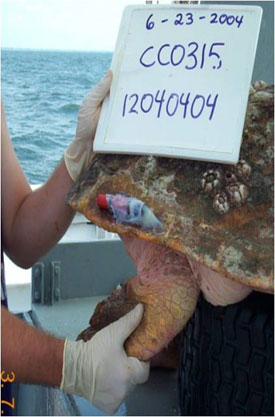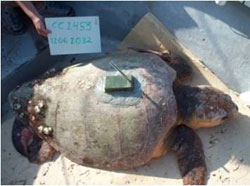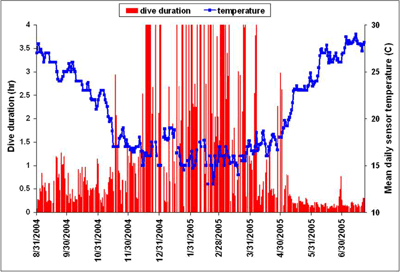Research - Swimming behavior

An acoustically-tagged juvenile loggerhead sea turtle after capture by trawling in the Charleston, SC shipping channel in June 2004. This sea turtle was tracked for 5.1 hr after release, during which time it swam along a nearly straight-line to the northeast. During seven subsequent acoustic surveys of the Charleston shipping channel in June and August, this turtle was never relocated. A summary of acoustic tracking efforts are provided in the 2004 Annual Report to NMFS (Maier et al. 2005).
In summer 2004, personnel from the SCDNR MRD attached acoustic transmitters to twelve juvenile loggerhead sea turtles captured by trawling in the Charleston, SC shipping channel. Although only short-term (i.e., day of release and sporadic locations up to 40 d later) data were collected in this research, several important observations were made. First, following capture, loggerhead sea turtles rapidly evacuated the area where they were released, generally moving along a linear trajectory in the direction of prevailing surface currents 22. Second, exodus away from the site of capture was short-lived, and loggerheads generally returned to the site of capture within several hours. This latter observation suggested that loggerheads in coastal waters off South Carolina may exhibit site fidelity on par with what has been reported for loggerheads in estuarine habitats in Pamlico-Core Sound 23 and Chesapeake Bay [24]. Although acoustic telemetry was abandoned in favor of satellite telemetry, future efforts to continuously monitor and therefore document fine-scale occurrence of loggerhead sea turtles at specific locations within shipping channels or other habitats of interest remain on our radar.
Between 2004 and 2007, satellite transmitters were attached to 35 juvenile loggerhead sea turtles captured in the Charleston, SC shipping channel [18] and 20 adult male loggerhead sea turtles captured in the Port Canaveral, FL shipping channel [21,25].
 A satellite-tagged adult male loggerhead sea turtle, named “Jaws” because of his tenacity, prior to release off Cape Canaveral, FL in April 2006. Unlike “Cougar”, “Jaws” remained off Cape Canaveral for seven months after release, at which point the transmitter ceased working,
A satellite-tagged adult male loggerhead sea turtle, named “Jaws” because of his tenacity, prior to release off Cape Canaveral, FL in April 2006. Unlike “Cougar”, “Jaws” remained off Cape Canaveral for seven months after release, at which point the transmitter ceased working,
In addition to recording geographic location, sensors included in the transmitters recorded diving behavior. On average about six months worth of information were gathered for each loggerhead sea turtle, but because adult males were tagged in April less data during cooler water periods were available overall. In general, both juveniles and adults make more frequent and shorter duration dives during summer and fall, as well as spend only about 4% of their time at the surface. In contrast, during winter and spring when water temperatures are cooler, loggerhead sea turtles make fewer and longer dives and remain at the surface about five times as long when they return to the surface to breathe. Typical summer dive duration is 20 minutes while in winter dives greater than two hours in duration are quite common. Shorter dive durations during periods when trawling for shrimp occurs illustrate the importance of outfitting trawl nets with Turtle Excluder Devices (TEDs). Minimal time spent on the water surface reinforces the validity of research trawling to capture sea turtles that are predominantly unavailable to be surveyed by aircraft in turbid coastal waters during the summer.

This graphic depicts a typical dive response by a juvenile loggerhead off the coast of South Carolina in response to seasonal water temperatures. From late summer through autumn, this loggerhead spent about 30 minutes under water (red bars) with each dive, and rarely spent more than an hour underwater at a time. However, at water temperatures below 20°C (68°F), this loggerhead abruptly changed diving behavior and often remained submerged for more than four hours at a time. Upon return to the near-shore waters off Charleston, SC the following spring, this loggerhead typically dove only 10 minutes at a time due to increased activity and cool bottom water temperatures.
22 Maier, P.P., A.L. Segars, M.D. Arendt and J. D. Whitaker. 2005. Examination of local movement and migratory behavior of sea turtles during spring and summer along the Atlantic coast off the southeastern United States. Annual Report to the Office of Protected Resources, NOAA Fisheries. Grant Number NA03NMF4720281, 29p.
23 Avens L, Braun-McNeill J, Epperly S, Lohmann KJ (2003) Site fidelity and homing behavior in juvenile loggerhead sea turtles (Caretta caretta). Marine Biology 143:211-220.
24 Byles RA (1988) Behavior and ecology of sea turtles from Chesapeake Bay, Virginia. Dissertation, College of William and Mary, Gloucester Point, Virginia.
25 Arendt, M.D., A.L. Segars, J.I. Byrd, J. Boynton, J.D. Whitaker, L. Parker, D.W. Owens, G. Blanvillain, J.M. Quattro, and M.A. Roberts. 2012. Distributional patterns of adult male loggerhead sea turtles (Caretta caretta) in the vicinity of Cape Canaveral, Florida, USA during and after a major annual breeding aggregation. Marine Biology 159(1):101–112.
